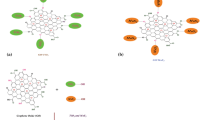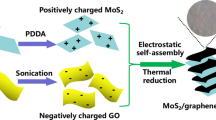Abstract
Molybdenum disulfide (MoS2) has a layered structure similar to graphite having a high surface-to-volume ratio, have triggered more attention for electrochemical energy storage devices. Herein, a honeycomb structure (g-C3N4) with potentially interconnected electron transport properties and unique chemical stability has been proposed as the next-generation electrode material for supercapacitors. Pristine MoS2 and MoS2/g-C3N4 heterostructures fabricated for supercapacitor electrode materials via a facile one-step hydrothermal process. It exhibits remarkable electrochemical performance were evaluated via cyclic voltammetry (CV), galvanostatic charge-discharge (GCD), and electrochemical impedance spectroscopy (EIS). It indicates an enhanced specific capacitance (Csp) value as 199.2 F/g at 1 A/g for 15% g-C3N4 composite MoS2 with excellent electrochemical stability remains 85% of capacity retention after 5000 cycles at a current density of 10 A/g. The asymmetric supercapacitor was fabricated with Activated carbon and 10% wt g-C3N4/MoS2. ASC devices (Asymmetric hybrid supercapacitors) exhibit a maximum energy density of 51.5 Wh/kg at 1 A/g and a power density of 26,367 W/kg at a current density of 10 A/g. It provides an innovative way to prepare efficient electrode material synergistically with conductive carbon matrices to enlarge Van der Waals gaps in layered MoS2, resulting in ultra-high energy storage materials for electrochemical applications.












Similar content being viewed by others
Data availability
The authors declare that the data supporting the findings of this study are available within the paper.
References
A. Riaz, M.R. Sarker, M.H.M. Saad, R. Mohamed, Review on comparison of different energy storage technologies used in micro-energy harvesting, wsns, low-cost microelectronic devices: challenges and recommendations. Sensors 21, 5041 (2021)
D. Kumar, R.K. Nema, S. Gupta, A comparative review on power conversion topologies and energy storage system for electric vehicles. Int. J. Energy Res. 44, 7863–7885 (2020)
J. Zhao, A.F. Burke, Electrochemical capacitors: materials, technologies, and performance. Energy Storage Mater. 36, 31–55 (2021)
J. Zhao, A.F. Burke, Electrochemical Capacitors: Performance Metrics and evaluation by testing and analysis. Adv. Energy Mater. 11, 1–29 (2021)
D. Majumdar, M. Mandal, S.K. Bhattacharya, Journey from supercapacitors to supercapatteries: recent advancements in electrochemical energy storage systems. Emergent Mater. 3, 347–367 (2020)
I.T. Bello, A.O. Oladipo, O. Adedokun, S.M. Dhlamini, Recent advances on the preparation and electrochemical analysis of MoS2-based materials for supercapacitor applications: a mini-review. Mater. Today Commun. 25, 101664 (2020)
M. Mohan, N.P. Shetti, T.M. Aminabhavi, Phase-dependent performance of MoS2 for supercapacitor applications. J. Energy Storage. 58, 106321 (2023)
K. Thiyagarajan, W.J. Song, H. Park, V. Selvaraj, S. Moon, J. Oh et al., Electroactive 1T-MoS2Fluoroelastomer ink for intrinsically stretchable solid-state In-Plane supercapacitors. ACS Appl. Mater. Interfaces. 13, 26870–26878 (2021)
A. Raza, J.Z. Hassan, M. Ikram, S. Ali, U. Farooq, Q. Khan et al., Advances in Liquid-Phase and Intercalation Exfoliations of Transition Metal Dichalcogenides to produce 2D Framework. Adv. Mater. Interfaces. 8, 1–46 (2021)
S. Lee, J. Hwang, D. Kim, H. Ahn, Oxygen incorporated in 1T/2H hybrid MoS2 nanoflowers prepared from molybdenum blue solution for asymmetric supercapacitor applications. Chem. Eng. J. 419, 129701 (2021)
K. Wu, X. Cao, M. Li, B. Lei, J. Zhan, M. Wu, Bottom-Up synthesis of MoS2/CNTs Hollow Polyhedron with 1T/2H hybrid phase for Superior Potassium-Ion Storage. Small. 16, 1–9 (2020)
J. Cherusseri, N. Choudhary, K. Sambath Kumar, Y. Jung, J. Thomas, Recent trends in transition metal dichalcogenide based supercapacitor electrodes. Nanoscale Horizons. 4, 840–858 (2019)
N. Joseph, Construction of few layered metallic MoS2 microspheres using glucose-induced carbon spheres and its application in symmetric supercapacitor device. J. Electroanal. Chem. 874, 114461 (2020)
N. Joseph, A.C. Bose, Metallic MoS2 grown on porous g-C3N4 as an efficient electrode material for supercapattery application. Electrochim. Acta. 301, 401–410 (2019)
Q. Ke, X. Zhang, W. Zang, A.M. Elshahawy, Y. Hu, Q. He et al., Strong charge transfer at 2H–1T phase boundary of MoS2 for superb high-performance Energy Storage. Small. 15, 1–11 (2019)
X. Wu, H. Zhang, J. Zhang, X.W. Lou, Recent advances on Transition Metal Dichalcogenides for Electrochemical Energy Conversion. Adv. Mater. 33, 1–24 (2021)
P. Bhojane, Recent advances and fundamentals of pseudocapacitors: materials, mechanism, and its understanding. J. Energy Storage. 45, 103654 (2022)
L. Lei, D. Huang, G. Zeng, M. Cheng, D. Jiang, C. Zhou et al., A fantastic two-dimensional MoS2 material based on the inert basal planes activation: electronic structure, synthesis strategies, catalytic active sites, catalytic and electronics properties. Coord. Chem. Rev. 399, 213020 (2019)
L. Zu, W. Zhang, L. Qu, L. Liu, W. Li, A. Yu et al., Mesoporous materials for Electrochemical Energy Storage and Conversion. Adv. Energy Mater. 10, 1–14 (2020)
Q. Abbas, R. Raza, I. Shabbir, A.G. Olabi, Heteroatom doped high porosity carbon nanomaterials as electrodes for energy storage in electrochemical capacitors: a review. J. Sci. Adv. Mater. Devices. 4, 341–352 (2019)
R. Dhilip Kumar, S. Nagarani, V. Sethuraman, S. Andra, V. Dhinakaran, Investigations of conducting polymers, carbon materials, oxide and sulfide materials for supercapacitor applications: a review. Chem. Pap. 76, 3371–3385 (2022)
R. Adalati, M. Sharma, S. Sharma, A. Kumar, G. Malik, R. Boukherroub et al., Metal nitrides as efficient electrode material for supercapacitors: a review. J. Energy Storage. 56, 105912 (2022)
S. Majumder, M. Shao, Y. Deng, G. Chen, Ultrathin sheets of MoS2/g-C3N4 composite as a good hosting material of sulfur for lithium–sulfur batteries. J. Power Sources. 431, 93–104 (2019)
S.A. Ansari, M.H. Cho, Simple and large scale construction of MoS2-g-C3N4 heterostructures using mechanochemistry for high performance Electrochemical Supercapacitor and visible light photocatalytic applications. Sci. Rep. 7, 1–11 (2017)
X. Yuan, S. Qiu, X. Zhao, Covalent fixing of MoS2Nanosheets with SnS nanoparticles anchored on g-C3N4/Graphene Boosting Fast Charge/Ion Transport for Sodium-Ion Hybrid Capacitors. ACS Appl. Mater. Interfaces. 13, 34238–34247 (2021)
S.M. Tan, A. Ambrosi, Z. Sofer, Å. Huber, D. Sedmidubský, M. Pumera, Pristine basal- and edge-plane-oriented molybdenite MoS2 exhibiting highly anisotropic properties. Chem. A Eur. J. 21, 7170–7178 (2015)
A. Gigot, M. Fontana, M. Serrapede, M. Castellino, S. Bianco, M. Armandi et al., Mixed 1T-2H phase MoS2/Reduced graphene oxide as active electrode for enhanced Supercapacitive Performance. ACS Appl. Mater. Interfaces. 8, 32842–32852 (2016)
I.I. Gurten Inal, Z. Aktas, Enhancing the performance of activated carbon based scalable supercapacitors by heat treatment. Appl. Surf. Sci. 514, 145895 (2020)
T. Chen, Y. Zhou, L. Luo, X. Wu, Z. Li, M. Fan et al., Preparation and characterization of heteroatom self-doped activated biocarbons as hydrogen storage and supercapacitor electrode materials. Electrochim. Acta 325, 134941 (2019)
R. Suresh Babu, R. Vinodh, de A.L.F. Barros, L.M. Samyn, K. Prasanna, M.A. Maier et al., Asymmetric supercapacitor based on carbon nanofibers as the anode and two-dimensional copper cobalt oxide nanosheets as the cathode. Chem. Eng. J. 366, 390–403 (2019)
F. Wang, F. Li, L. Ma, M. Zheng, Few-layer MoS2 nanosheets encapsulated in N-Doped Carbon Hollow spheres as Long-Life Anode materials for Lithium-ion batteries. Chem. A Eur. J. 25, 14598–14603 (2019)
Y. Zhai, D. Zhu, X. Ruan, F. Luo, Oriented flaky carbonyl iron and MoS2/polyurethane composite with improved microwave absorption at thin thickness by shear force. J. Mater. Sci. Mater. Electron. 31, 22768–22779 (2020)
A. Kumar, P. Kumar, C. Joshi, M. Manchanda, R. Boukherroub, S.L. Jain, Nickel decorated on phosphorous-doped carbon nitride as an efficient photocatalyst for reduction of nitrobenzenes. Nanomaterials 6, 59 (2016)
Y. Wang, X. Zhang, X. Ding, Y. Li, B. Wu, P. Zhang et al., Stitching Graphene sheets with Graphitic Carbon Nitride: constructing a highly thermally conductive rGO/g-C3N4Film with excellent heating capability. ACS Appl. Mater. Interfaces. 13, 6699–6709 (2021)
X. Dang, M. Xie, F. Dai, J. Guo, J. Liu, X. Lu, Ultrathin 2D/2D ZnIn2S4/g-C3N4 Nanosheet Heterojunction with Atomic-Level Intimate Interface for Photocatalytic Hydrogen Evolution under visible light. Adv. Mater. Interfaces. 8, 1–13 (2021)
F.Z. Wang, M.J. Zheng, B. Zhang, C.Q. Zhu, Q. Li, L. Ma et al., Ammonia intercalated flower-like MoS2 nanosheet film as electrocatalyst for high efficient and stable hydrogen evolution. Sci. Rep. 6, 1–9 (2016)
D. Monga, D. Ilager, N.P. Shetti, S. Basu, T.M. Aminabhavi, 2D/2d heterojunction of MoS2/g-C3N4 nanoflowers for enhanced visible-light-driven photocatalytic and electrochemical degradation of organic pollutants. J. Environ. Manage. 274, 111208 (2020)
X. Wang, W. Xiong, X. Li, Q. Zhao, S. Fan, M. Zhang et al., Fabrication of MoS2@g-C3N4 core-shell nanospheres for visible light photocatalytic degradation of toluene. J. Nanoparticle Res. 20, 1 (2018)
H. Tran Huu, M.D.N. Thi, V.P. Nguyen, L.N. Thi, T.T.T. Phan, Q.D. Hoang et al., One-pot synthesis of S-scheme MoS2/g-C3N4 heterojunction as effective visible light photocatalyst. Sci. Rep. 11, 1–12 (2021). https://doi.org/10.1038/s41598-021-94129-0
N. Feng, R. Meng, L. Zu, Y. Feng, C. Peng, J. Huang et al., A polymer-direct-intercalation strategy for MoS2/carbon-derived heteroaerogels with ultrahigh pseudocapacitance. Nat. Commun. 10, 1372 (2019)
Z. Bi, Q. Kong, Y. Cao, G. Sun, F. Su, X. Wei et al., Biomass-derived porous carbon materials with different dimensions for supercapacitor electrodes: a review. J. Mater. Chem. A 7, 16028–16045 (2019)
N. Joseph, P. Muhammed Shafi, A. Chandra Bose, Metallic 1T-MoS2 with defect induced additional active edges for high performance supercapacitor application. New. J. Chem. 42, 12082–12090 (2018)
J. Xu, Z. Huang, H. Ji, H. Tang, G. Tang, H. Jiang, g-C3N4 anchored with MoS2 ultrathin nanosheets as high performance anode material for supercapacitor. Mater. Lett. 241, 35–38 (2019)
H. Wang, T. Yao, C. Li, L. Meng, Y. Cheng, Constructing three-dimensional ordered porous MoS2/C hierarchies for excellent high-rate long-life pseudocapacitive sodium storage. Chem. Eng. J. 397, 125385 (2020)
Acknowledgements
The authors acknowledges the SRM Institute of Science and Technology, Kattankulathur, for their good support in providing required instrument facilities.
Funding
The authors declare that no funds, grants, or other support were received during the preparation of this manuscript.
Author information
Authors and Affiliations
Contributions
All authors contributed to the study conception and design of material preparation, data collection. Analysis was performed by TKS, KP, MG and KS. The first draft of the manuscript was written by TKS, and all authors commented on the previous version of the manuscript. All the authors read and approved the final manuscript.
Corresponding author
Ethics declarations
Competing interests
The authors have no relevant financial or non-financial interests to disclose.
Informed consent
The present work does not involve any animal or human participants”.
Additional information
Publisher’s Note
Springer Nature remains neutral with regard to jurisdictional claims in published maps and institutional affiliations.
Rights and permissions
Springer Nature or its licensor (e.g. a society or other partner) holds exclusive rights to this article under a publishing agreement with the author(s) or other rightsholder(s); author self-archiving of the accepted manuscript version of this article is solely governed by the terms of such publishing agreement and applicable law.
About this article
Cite this article
Selvam, T.K., Prakash, K., Geerthana, M. et al. Enhanced high energy and power density hybrid asymmetric supercapacitor based on 2D layered MoS2/g-C3N4 electrode materials. J Mater Sci: Mater Electron 34, 2199 (2023). https://doi.org/10.1007/s10854-023-11622-0
Received:
Accepted:
Published:
DOI: https://doi.org/10.1007/s10854-023-11622-0




